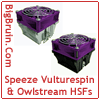|
 Posted: July 28, 2003 Posted: July 28, 2003
Author: Jason Kohrs
Manufacturer: Speeze
Source: Speeze
Brief installation instructions are included with both heatsinks (which are also available on the Speeze website), but the process is very simple and didn’t cause any problems. After attaching the one side of the heatsink clip to the motherboard by hand, a small screwdriver was used on each one to secure it to the lug on the other side. Both clips provide a fairly snug grip, but the 3-lug design of the Vulturespin does a slightly better job than the 1-lug design of the Owlstream at keeping the heatsink in place. Gently twisting the heatsinks revealed a little bit of play in each, which isn’t uncommon, but there was definite less play in the Vulturespin.
|
Owlstream Installed
|
Vulturespin Installed
|
|
|
|
|
Testing was conducted with the following hardware
4AMD Athlon XP2200+ CPU
4Asus A7N8X Motherboard
4512MB Geil PC3200 DDR SDRAM
4MSI GeForce 4 MX440 AGP Card
Software involved in the testing included:
4Microsoft Windows XP Professional (operating system)
4Motherboard Monitor 5.3.0.0 (all temperature / rpm / voltage readings)
4SiSoft Sandra 2003 Professional (for stress testing)
4Folding@Home 3 - Text Only Console Version (for stress testing)
For comparison purposes I am going to test the two Speeze Heatsinks against the Vantec AeroFlow heatsink, and the Thermaltake Volcano 7 heatsink (fitted with ThermalTake's original Smart Fan with thermally controlled speed adjustment). Testing head-to-head with these two heatsinks will provide a decent point of reference for analyzing the performance capabilities of both the Vulturespin and the Owlstream.
For the "Idle Temperature" results, the cpu was allowed to run for 1 hour with no applications in use. For the "Load Temperature" results, the cpu was allowed to run for 1 hour with both Folding@Home 3 and the "Burn In Wizard" feature of SiSoft Sandra 2003 Professional launched. For optimal stress testing, only the CPU Arithmetic Benchmark and CPU Multimedia Benchmark modules of the "Burn In Wizard" were selected. These programs provide 100% cpu utilization, which in turn generates more heat for the heatsink to dissipate.
The pre-installed thermal paste had become unusable during the course of the review and was completely removed by the time testing started. Each heatsink was then prepared with a razor thin coating of generic, white thermal paste, and then installed into my system with the case side panel removed (so as not to create any potential interference with the airflow). For reference, I was able to maintain a room temperature of 24 degress Celsius, and case temperature between 32 and 33 degrees Celsius, for all tests. See chart below for complete results:
Taking a look at the chart above, you can see that the two Speeze coolers provided respectable temperatures, but were not able to out-cool the competition. At “idle” conditions, all of the heatsinks tested were within a few degrees of each other, and all were at comfortable levels. The “load” conditions revealed that the Owlstream and Vulturespin weren’t quite as strong as the other two, but the temperatures were still nothing to be alarmed about. According to Motherboard Monitor 5, the actual fan speed of the Owlstream was 2550 RPM, and the actual fan speed of the Vulturespin was 2190 RPM.
Both coolers provided by Speeze use low flow 80mm fans that create a minimal amount of noise, similar to that of the Vantec Aeroflow. If you haven’t experienced a cooler with a TMD fan (like the Aeroflow), they are impressively quiet, and nearly undetectable with a few case fans running. The Volcano 7 is particularly load in comparison, but the fan is moving at upward of 4800 RPM to accomplish its level of cooling. The use of a lower flow fan on the Vulturespin, seems to eliminate any perceived advantage that the copper core may give it over the Owlstream. The thermal results are just about identical, and the cooling performance of either Speeze heatsink might benefit from a higher flow fan (which would obviously kill the low noise output). But, the target market of the Vulturespin is obviously people willing to sacrifice a bit of cooling performance in favor of low noise... and to quote Speeze: “who wants to have a air plane as a computer system”.
Although I would not recommend them for overclockers or higher powered processors, the Vulturespin and Owlstream are solid performers for typical desktop applications, especially if noise is a serious consideration. This performance is supported by Speeze’s reputation for reliability that they back up with a minimum of a 5 year warranty! You won’t find many companies willing to offer that.
As mentioned at the beginning of the review, the Vulturespin and Owlstream are not yet available for purchase. At the time this review was posted, they were anticipated to arrive at retailers such as Newegg and Tiger Direct within a few weeks. Once they hit the shelves, pricing is estimated to be about $15.50 (US) on the Owlstream and $20.50 (US) on the Vulturespin. These prices are definitely in line with the competition, and the performance offered versus the price paid will be very attractive to many potential users.
Pros:
4Very quiet, excellent option for environment where low noise is a must.
4Heatsink comes complete with fan, fan grill, and thermal paste.
4Unique styling... the purple looks surprisingly cool.
4Competitive estimated retail prices.
Cons:
4Not recommended for overclocking (cooling performance might not handle extreme conditions).
Special thanks to Speeze for providing the Vulturespin and Owlstream coolers for review!
Please drop by the BigBruin.Com Forum and feel free to discuss this review.
Page 1 | Page 2 | Review Index
|